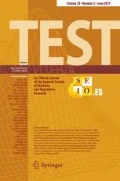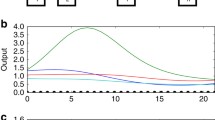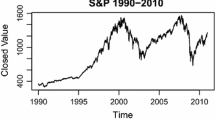Abstract
In longitudinal studies, it is common to observe repeated measurements data from a sample of subjects where noisy measurements are made at irregular times, with a random number of measurements per subject. Often a reasonable assumption is that the data are generated by the trajectories of a smooth underlying stochastic process. In some cases, one observes multivariate time courses generated by a multivariate stochastic process. To understand the nature of the underlying processes, it is then of interest to relate the values of a process at one time with the value it assumes at another time, and also to relate the values assumed by different components of a multivariate trajectory at the same time or at specific times selected for each trajectory. In addition, an assessment of these relationships will allow to predict future values of an individual’s trajectories.
Derivatives of the trajectories are frequently more informative than the time courses themselves, for instance, in the case of growth curves. It is then of great interest to study the estimation of derivatives from sparse data. Such estimation procedures permit the study of time-dynamic relationships between derivatives and trajectory levels within the same trajectory and between the components of multivariate trajectories. Reviewing and extending recent work, we demonstrate the estimation of corresponding empirical dynamical systems and demonstrate asymptotic consistency of predictions and dynamic transfer functions. We illustrate the resulting prediction procedures and empirical first-order differential equations with a study of the dynamics of longitudinal functional data for the relationship of blood pressure and body mass index.
Similar content being viewed by others
References
Ash RB, Gardner MF (1975) Topics in stochastic processes. Probability and mathematical statistics, vol 27. Academic Press [Harcourt Brace Jovanovich Publishers], New York
Besse P, Ramsay JO (1986) Principal components analysis of sampled functions. Psychometrika 51:285–311
Cai T, Hall P (2006) Prediction in functional linear regression. Ann Stat 34:2159–2179
Cardot H, Ferraty F, Mas A, Sarda P (2003a) Testing hypotheses in the functional linear model. Scand J Stat 30:241–255
Cardot H, Ferraty F, Sarda P (2003b) Spline estimators for the functional linear model. Stat Sin 13:571–591
Cardot H, Crambes C, Kneip A, Sarda P (2007) Smoothing splines estimators in functional linear regression with errors-in-variables. Comput Stat Data Anal 51:4832–4848
Castro PE, Lawton WH, Sylvestre EA (1986) Principal modes of variation for processes with continuous sample curves. Technometrics 28:329–337
Chiang C-T, Rice JA, Wu CO (2001) Smoothing spline estimation for varying coefficient models with repeatedly measured dependent variables. J Am Stat Assoc 96:605–619
Chiou J-M, Müller H-G, Wang J-L, Carey JR (2003) A functional multiplicative effects model for longitudinal data, with application to reproductive histories of female medflies. Stat Sin 13:1119–1133
Chiou J-M, Müller H-G, Wang J-L (2004) Functional response models. Stat Sin 14:675–693
Cuevas A, Febrero M, Fraiman R (2002) Linear functional regression: the case of fixed design and functional response. Can J Stat 30:285–300
Dauxois J, Pousse A, Romain Y (1982) Asymptotic theory for the principal component analysis of a vector random function: some applications to statistical inference. J Multivar Anal 12:136–154
Dubin JA, Müller H-G (2005) Dynamical correlation for multivariate longitudinal data. J Am Stat Assoc 100:872–881
Escabias M, Aguilera AM, Valderrama MJ (2004) Principal component estimation of functional logistic regression: discussion of two different approaches. J Nonparametr Stat 16:365–384
Eubank RL, Hsing T (2008) Canonical correlation for stochastic processes. Stoch Proc Appl 118:1634–1661
Fan J, Gijbels I (1996) Local polynomial modelling and its applications. Monographs on statistics and applied probability, vol. 66. Chapman & Hall, London
Fan J, Zhang J-T (2000) Two-step estimation of functional linear models with applications to longitudinal data. J R Stat Soc, Ser B 62:303–322
Fan J, Zhang W (2008) Statistical methods with varying coefficient models. Stat Interface 1:179–195
Faraway JJ (1997) Regression analysis for a functional response. Technometrics 39:254–261
Ferraty F, Mas A, Vieu P (2007) Nonparametric regression on functional data: inference and practical aspects. Aust N Z J Stat 49:459–461
Ferraty F, Vieu P (2006) Nonparametric functional data analysis. Springer, New York
Gasser T, Kneip A (1995) Searching for structure in curve samples. J Am Stat Assoc 90:1179–1188
Gasser T, Müller H-G (1984) Estimating regression functions and their derivatives by the kernel method. Scand J Stat 11:171–185
Gasser T, Müller H-G, Köhler W, Molinari L, Prader A (1984) Nonparametric regression analysis of growth curves. Ann Stat 12:210–229
Gervini D, Gasser T (2004) Self-modeling warping functions. J R Stat Soc, Ser B 66:959–971
Gervini D, Gasser T (2005) Nonparametric maximum likelihood estimation of the structural mean of a sample of curves. Biometrika 92:801–820
Grenander U (1950) Stochastic processes and statistical inference. Ark Mat 1:195–277
Hall P, Horowitz JL (2007) Methodology and convergence rates for functional linear regression. Ann Stat 35:70–91
Hall P, Müller H-G, Wang J-L (2006) Properties of principal component methods for functional and longitudinal data analysis. Ann Stat 34:1493–1517
Hall P, Müller H-G, Yao F (2008) Modeling sparse generalized longitudinal observations with latent Gaussian processes. J R Stat Soc, Ser B 70:730–723
He G, Müller H-G, Wang J-L (2000) Extending correlation and regression from multivariate to functional data. In: Puri ML (ed) Asymptotics in statistics and probability. VSP International Science Publishers
He G, Müller H-G, Wang J-L (2003) Functional canonical analysis for square integrable stochastic processes. J Multivar Anal 85:54–77
He G, Müller H-G, Wang J-L (2004) Methods of canonical analysis for functional data. J Stat Plann Inference 122:141–159
Heckman NE, Zamar RH (2000) Comparing the shapes of regression functions. Biometrika 87:135–144
Hoover DR, Rice JA, Wu CO, Yang L-P (1998) Nonparametric smoothing estimates of time-varying coefficient models with longitudinal data. Biometrika 85:809–822
Hotelling H (1936) Relations between two sets of variates. Biometrika 28:321–377
Huang JZ, Wu CO, Zhou L (2004) Polynomial spline estimation and inference for varying coefficient models with longitudinal data. Stat Sin 14:763–788
James GM (2002) Generalized linear models with functional predictors. J R Stat Soc, Ser B 64:411–432
James GM, Hastie TJ, Sugar CA (2000) Principal component models for sparse functional data. Biometrika 87:587–602
Jank W, Shmueli G (2006) Functional data analysis in electronic commerce research. Stat Sci 21:155–166
Karhunen K (1946) Zur Spektraltheorie stochastischer Prozesse. Ann Acad Sci Fenn, Ser A, I, Math 1946:7
Kato T (1995) Perturbation theory for linear operators. Springer, Berlin
Kirkpatrick M, Heckman N (1989) A quantitative genetic model for growth, shape, reaction norms, and other infinite-dimensional characters. J Math Biol 27:429–450
Kneip A, Ramsay JO (2008) Combining registration and fitting for functional models. J Am Stat Assoc 103:1155–1165
Leurgans SE, Moyeed RA, Silverman BW (1993) Canonical correlation analysis when the data are curves. J R Stat Soc, Ser B 55:725–740
Lin X, Carroll RJ (2001a) Semiparametric regression for clustered data. Biometrika 88:1179–1185
Lin X, Carroll RJ (2001b) Semiparametric regression for clustered data using generalized estimating equations. J Am Stat Assoc 96:1045–1056
Liu B, Müller H-G (2009) Estimating derivatives for samples of sparsely observed functions, with application to on-line auction dynamics. J Am Stat Assoc 104:704–714
Malfait N, Ramsay JO (2003) The historical functional linear model. Can J Stat 31:115–128
Mas A, Pumo B (2009) Functional linear regression with derivatives. J Nonparametr Stat 21:19–40
Müller H-G (2005) Functional modelling and classification of longitudinal data. Scand J Stat 32:223–240
Müller H-G (2008) Functional modeling of longitudinal data. In: Fitzmaurice G, Davidian M, Verbeke G, Molenberghs G (eds) Longitudinal data analysis. Handbooks of modern statistical methods. Chapman & Hall/CRC, New York, pp 223–252
Müller H-G, Stadtmüller U (2005) Generalized functional linear models. Ann Stat 33:774–805
Müller H-G, Yao F (2006) Regressing longitudinal response trajectories on a covariate. In: Fan J, Koul HL (eds) Frontiers in statistics. Festschrift for Peter Bickel Imperial College Press, London
Müller H-G, Yao F (2008) Functional additive models. J Am Stat Assoc 103:1534–1544
Müller H-G, Zhang Y (2005) Time-varying functional regression for predicting remaining lifetime distributions from longitudinal trajectories. Biometrics 61:1064–1075
Müller H-G, Chiou J-M, Leng X (2008) Inferring gene expression dynamics via functional regression analysis. BMC Bioinform 9:60
Opgen-Rhein R, Strimmer K (2006) Inferring gene dependency networks from genomic longitudinal data: a functional data approach. REVSTAT—Stat J 4:53–65
Pearson JD, Morrell CH, Brant LJ, Landis PK (1997) Gender differences in a longitudinal study of age associated changes in blood pressure. J Gerontol A Biol Sci Med Sci 52:177–183
Qu A, Li R (2006) Quadratic inference functions for varying-coefficient models with longitudinal data. Biometrics 62:379–391
Ramsay JO, Dalzell CJ (1991) Some tools for functional data analysis. J R Stat Soc, Ser B 53:539–572
Ramsay JO, Li X (1998) Curve registration. J R Stat Soc, Ser B 60:351–363
Ramsay JO, Silverman BW (2002) Applied functional data analysis. Springer series in statistics. Springer, New York
Ramsay JO, Silverman BW (2005) Functional data analysis, 2nd edn. Springer series in statistics. Springer, New York
Rao CR (1958) Some statistical methods for comparison of growth curves. Biometrics 14:1–17
Reddy SK, Dass M (2006) Modeling on-line art auction dynamics using functional data analysis. Stat Sci 21:179–193
Rice JA (2004) Functional and longitudinal data analysis: perspectives on smoothing. Stat Sin 14:631–647
Rice JA, Silverman BW (1991) Estimating the mean and covariance structure nonparametrically when the data are curves. J R Stat Soc, Ser B 53:233–243
Rice JA, Wu CO (2001) Nonparametric mixed effects models for unequally sampled noisy curves. Biometrics 57:253–259
Şentürk D, Müller H-G (2008) Generalized varying coefficient models for longitudinal data. Biometrika 95:653–666
Şentürk D, Müller H-G (2009) Functional varying coefficient models for longitudinal data. Preprint
Service SK, Rice JA, Chavez FP (1998) Relationship between physical and biological variables during the upwelling period in Monterey Bay. Deep-Sea Res, Part II, Top Stud Oceanogr 45:1669–1685
Shi M, Weiss RE, Taylor JMG (1996) An analysis of paediatric CD4 counts for acquired immune deficiency syndrome using flexible random curves. Ann Stat 45:151–163
Shock NW, Greulich RC, Andres R, Lakatta EG, Arenberg D, Tobin JD (1984) Normal human aging: the Baltimore longitudinal study of aging. In: NIH publication no 84-2450. U.S. Government Printing Office, Washington, DC
Staniswalis JG, Lee JJ (1998) Nonparametric regression analysis of longitudinal data. J Am Stat Assoc 93:1403–1418
Tang R, Müller H-G (2008) Pairwise curve synchronization for functional data. Biometrika 95:875–889
Tang R, Müller H-G (2009) Time-synchronized clustering of gene expression trajectories. Biostatistics 10:32–45
Wang N, Carroll RJ, Lin X (2005) Efficient semiparametric marginal estimation for longitudinal/clustered data. J Am Stat Assoc 100:147–157
Wang S, Jank W, Shmueli G, Smith P (2008) Modeling price dynamics in ebay auctions using principal differential analysis. J Am Stat Assoc 103(483):1100–1118
Wu CO, Yu KF, Chiang C-T (2000) A two-step smoothing method for varying-coefficient models with repeated measurements. Ann Inst Stat Math 52:519–543
Yao F, Lee TCM (2006) Penalized spline models for functional principal component analysis. J R Stat Soc, Ser B 68:3–25
Yao F, Müller H-G, Wang J-L (2005a) Functional data analysis for sparse longitudinal data. J Am Stat Assoc 100:577–590
Yao F, Müller H-G, Wang J-L (2005b) Functional linear regression analysis for longitudinal data. Ann Stat 33:2873–2903
Zhao X, Marron JS, Wells MT (2004) The functional data analysis view of longitudinal data. Stat Sin 14:789–808
Zhou L, Huang JZ, Carroll R (2008) Joint modelling of paired sparse functional data using principal components. Biometrika 95:601–619
Author information
Authors and Affiliations
Corresponding author
Additional information
This invited paper is discussed in the comments available at: doi:10.1007/s11749-009-0174-6, doi:10.1007/s11749-009-0175-5, doi:10.1007/s11749-009-0177-3, doi:10.1007/s11749-009-0178-2, doi:10.1007/s11749-009-0179-1, doi:10.1007/s11749-009-0180-8, doi:10.1007/s11749-009-0181-7, doi:10.1007/s11749-009-0182-6.
Rights and permissions
About this article
Cite this article
Müller, HG., Yang, W. Dynamic relations for sparsely sampled Gaussian processes. TEST 19, 1–29 (2010). https://doi.org/10.1007/s11749-009-0176-4
Published:
Issue Date:
DOI: https://doi.org/10.1007/s11749-009-0176-4




